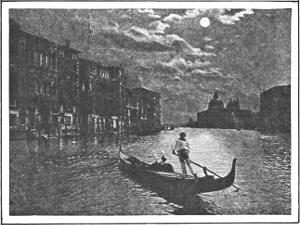
Wish you the best for you and your family – Happy Eid

Wish you the best for you and your family – Happy Eid
Prof. Wael Badawy @wbadawy @waelbadawy

Privacy and security of the personal data of Egyptian citizens and foreigner
The draft data protection law is concerned with the privacy and security of the personal data of Egyptian citizens and foreigner individuals who live in Egypt. It is Egypt’s version of the GDPR.
The draft law protects any personal data, if it leads to identifying an individual. Examples include his/her name, address or photo. The law provides an additional layer of protection to sensitive data, such as an individual’s religion and his/her medical information. It sets the rights of individuals in relation to their personal information, such as their right to ask that their data be deleted, and the obligations of organizations collecting or processing data.
The main features of the draft law that may affect you as a business are:
- Limitation on the ability of organizations to collect, use, transfer or retain personal data.
- Duty to obtain a license and other compliance requirements, if data is controlled or processed (which is the case with all organizations).
- Regulations addressing duties of companies’ carrying out direct marketing.
Who should worry and why?
Any person collecting, controlling, processing and/or holding personal data for uses that are non-personal. This would basically include every business, company or other organization operating in Egypt. The consequences for non-compliance are severe; ranging from imprisonment and fines and up to revoking data related licenses and publication of the criminal verdict in media outlets.
How much time do you have to set your house in order?
Those included within the scope of the law will be expected to comply within 18 months from the issuance of the law (that is if the executive regulations are issued on schedule).
What should you do?
The starting point is to track the data cycle from when your organization receives the data, processes, and stores it until the data is deleted. Next, make sure you comply with each of the data protection principles as they have been emptied into legal obligations (see more on that below). Document this in a policy and implement it. Don’t forget to train your people.
Now you have an idea of the main highlights of the law and you want to understand more how data is handled under the law? Deep dive into the below explanation of the data protection principles adopted by the law.
Seven key principles for data protection
These are set in stone under the GDPR and mirrored in the Law:
- Lawfulness, fairness, and transparency
- Purpose limitation
- Data minimization
- Accuracy
- Storage limitation
- Integrity and confidentiality (security)
- Accountability
We fleshed out three of the principles for you to get a clear idea:
- Lawfulness, fairness, and transparency
The principle – You must not collect or keep any personal data in electronic or physical form, except for lawful purposes, such as one of the following purposes:
- The person whose data is being collected has given his/her consent.
- The relevant document is anonymized.
- The company has a legitimate reason to keep the data.
- There is a legal or contractual obligation.
You must reveal the purpose of the data collection and processing.
How to comply? Ask yourself why you are collecting this data and if you are also processing it. Make sure your reasons are legitimate; where possible obtain the person’s consent. Inform the data subject.
Obtaining consent is the gold standard. Usually, document anonymization is used in medical applications and research.
Example – think of a financial institution keeping personal data to comply with its Know Your Customer (KYC) requirements under anti-money laundry laws.
- Accuracy
The principle – You must (i) ensure that the data collected is correct, and (ii) correct any inaccurate personal data.
How to comply? – Map your data; review it, make sure it is correct; and put in place workflows that allow data subjects to review their data and correct it.
Example – when a person’s address is part of the data collected, and the individual does not reside at that location anymore, you need to (i) correct the data; or (ii) include such address as the last known address/previous place of residence.
- Integrity and confidentiality (security)
The principle – You need to take the necessary technical and organizational measures for the protection of personal data to ensure there is no breach of confidentiality, hacking, destruction, alterations or damage to the personal data. You also need to appoint a data protection officer, who shall be registered with the regulator. This officer must carry out regular evaluation and checks of the data protection systems and document that.
How to comply? – Appoint a data protection officer; review your systems and workflows; draft a data security policy and implement it; train your people; and report data leakages when they happen.
Example – A business should not only address cybersecurity risks; it should also put in place technical measures (e.g. a secure process for disposal of documents containing Personal Data; securing access to locations/premises containing documents/devices with access to personal data). In addition, a business should take organizational measures (e.g. ensuring coordination between the relevant members of the organization on security processes like disposal of IT equipment which were used to store personal data).
What needs to change in the current draft?
Data protection is good and eventually leads to a better business environment for all of us. But, we are mostly worried about the imprisonment sanctions which, as currently drafted, are extraterritorial. This represents a personal threat to senior executives in Silicon Valley and Seattle. We see this as a disabling threat that may cause some companies to reconsider their investments in Egypt. The draft law is essentially borrowed from the GDPR. But on the sanctions part, we seem to have lost our sense of where the world is going and decided to go in the opposite direction.
Our Technology & Innovation team welcomes your questions: wael@waelbadawy.com

The power of one cent
What is the power of one cent?
To answer this question, imagine that one cent doubles every day. As shown in the table, one cent after 9 days can buy you a coffee at $2.56. One cent, after 20 days, can buy a car at $5,242.88. One cent after 30 days can buy your dream that is worth $5 Million dollars. AND, you keep it to the following day, you will become a double-digit millionaires. One cent will be a $1,374,389,534.72 on day 38 and will be $5,497,558,138.88 on day 40.
Then what? The model above presents the strength of a network. I can recruit my team to double every day, or a week or a month. I can reach a powerful result if I have the passion and dedication. The model is also applicable to sales, if I can double my sales every day, I can reach amazing business size after 30 cycles. The cycle can be one week, one month, or even one year. Just keep it doubling and do not rush and have the passion to be a billionaire starting with one cent.
Hierarchical Adaptive Structure Mesh for Efficient Video Coding
Wael Badawy, “Hierarchical Adaptive Structure Mesh for Efficient Video Coding,” The International Journal on Image and Video Processing, Vol. 17, November 2001
PALACE AND CAMPANILE
A Trip Around the World with DWIGHT L. ELMENDORF, Lecturer and Traveler.
Close beside the cathedral of St. Mark stands the square Campanile, the most prominent feature in all Venetian views. Standing 325 feet high, the Campanile always dominated the picturesque low stretch of Venice’s skyline and gave a peculiar distinction to the whole scene. It seemed indeed to many Venetians and to lovers of Venice all over the world that the city had lost its crowning feature when, in 1902, the Campanile collapsed. It was originally erected in 900 and rebuilt in 1329. After it had fallen Venice seemed maimed, and the hearts of thousands felt the depression until the tower was rebuilt and the city could once again hold up its beautiful head. A new tower was built by Piacentini (pee´-ah-chen-tee´-nee) during the years 1905 to 1911, and on completion it was consecrated with most impressive ceremonies.
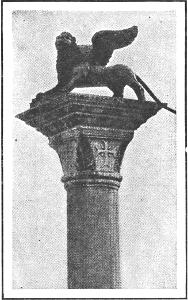
LION OF ST. MARK’S
The Doge’s Palace was originally founded about 800; but was destroyed by fire five times, and each time rebuilt on a grander scale. The older part of the present edifice was built in 1309; while the west wing, facing on the piazzetta, was built between 1424 and 1438 by the celebrated architects Buon, father and son.
In gazing at the Doge’s Palace the eye is first caught by the upper arcade. From there the sentences of the “Council of Ten” were pronounced—listened to by the assembled people in silence and in awe.
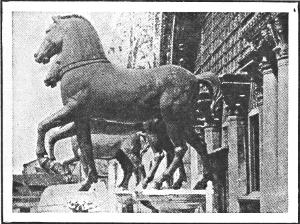
THE BRONZE HORSES OF ST. MARK’S
These horses are among the finest of ancient bronzes. They probably once adorned the triumphal arch of Nero, emperor of Rome.
The columns of this arcade are most beautiful, and have been pointed to with pride for years. Ruskin describes the detail of the sculptured columns, and declares that they are the finest of their kind in Europe. The interior of the Doge’s Palace is wonderful. Tintoretto’s painting of “Paradise” is there, a marvel in size and in detail. The residence of the Doges and the apartment in which the authorities held their meetings are there, revealing still much of their ancient glory. The palace is virtually a museum, and it shows a great display of fine paintings, containing, among others, notably works of Tintoretto, Paul Veronese, (vay-ro-nay´-seh) and Palma Giovane (jo-vah´-neh). Days could be spent profitably wandering through these halls, studying the treasures of art and history to be found there.

THE PALACE OF THE DOGES
The Doge’s Palace is said to have been founded beside the church of St. Theodore about 800 for the first Doge of Venice. It has been rebuilt and altered many times.
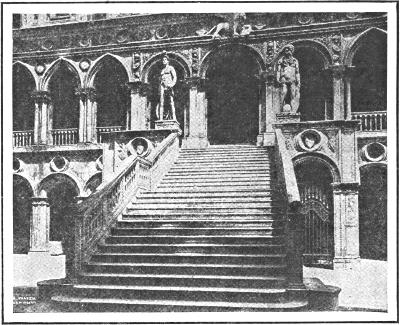
SCALA DEI GIGANTI, DOGE’S PALACE
The Stairway of the Giants, so called from the colossal statues of Mars and Neptune at the top, leads to the Palace of the Doges. On the highest landing of these steps, in the later days of the Republic, the Doges were crowned.
ST. MARK’S
A Trip Around the World with DWIGHT L. ELMENDORF, Lecturer and Traveler.
It is not the physical conditions alone that make Venice unique. In the beauty and interest of its domestic architecture it ranks before any city in the world. The mosaics of Venice have been famous for centuries, and are today the marvel of all who see them. The spot where Venice has massed the gems of her beauty is St. Mark’s Place.
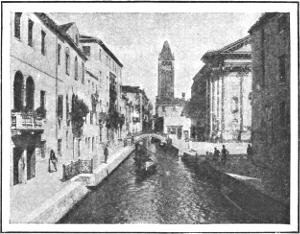
A VENETIAN CANAL
One of the smaller and narrower canals of Venice.
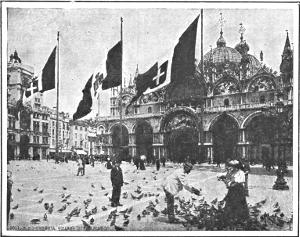
ST. MARK’S CATHEDRAL
The remains of St. Mark, the tutelary saint of Venice, are said to have been brought from Alexandria in 829, and to have been buried here.
The view of Venice most familiar to stay-at-home bodies is the one to be had from across the water looking at St. Mark’s Place, and including, besides the cathedral of St. Mark, the Doge’s (doje) Palace and Campanile (cam-pa-nee´-le) Tower, and in some cases a glimpse of the Bridge of Sighs. The Piazza of St. Mark is called the “Heart of Venice.” All the life of the city surges there at certain times, then sweeps from there through its various channels. It is gayest on summer evenings, when the population turns out to enjoy the fresh air and listen to the military band. At that time the piazza is brilliant with fashionable people. Go there on a moonlight night, and you will find it a dream of beauty. You must see, of course, the pigeons of St. Mark’s. Flocks of them circle about the square or gather in groups on the pavement, wherever food is to be found. The pigeons of St. Mark’s used to be fed at public expense. It is not necessary now: there are always plenty of travelers that will pay them this pleasant toll for the sake of being photographed in their company. St. Mark’s Place is 191 yards in length, and in width 61 yards on one side and 90 on the other. The beautiful effect of it can hardly be expressed. It is paved with trachyte and marble, and surrounded by buildings that are not only important historically but most interesting architecturally.
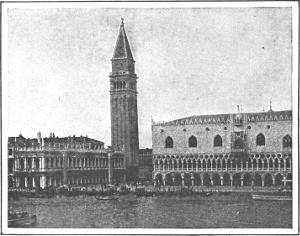
THE RECONSTRUCTED CAMPANILE OF ST. MARK’S
The Church of St. Mark, now a cathedral, was begun in 830. The year before that the bones of St. Mark, the saint of Venice, were brought from Alexandria, and they now lie buried in the church. This marvelous building is Romanesque in style. During the eleventh and twelfth centuries it was remodeled and decorated with most lavish magnificence. In the fifteenth century it received some Gothic additions which enhanced its effect. In such short space as this it is impossible to do justice to the beauty of St. Mark’s. It is best by far to rest on what Ruskin has said in his “Stones of Venice”:
“The effects of St. Mark’s depend not only upon the most delicate sculpture in every part, but eminently on its color also, and that the most subtle, variable, inexpressible color in the world,—the color of glass, of transparent alabaster, of polished marble, and lustrous gold.”
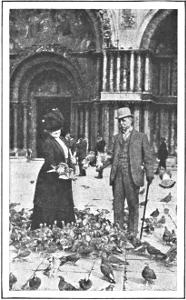
AMERICANS FEEDING THE DOVES OF ST. MARK’S
The building is in the form of a Greek cross, with mosaics covering more than 4,500 square feet. Over the upper entrance are four horses in gilded bronze, counted among the finest of ancient bronzes. They may have adorned the triumphal arch of Nero or that of Trajan in Rome. The Emperor Constantine sent them to Constantinople, and from there they were brought by the Doge Dandolo to Venice in 1204. These horses were taken to Paris by Napoleon in 1797, and for awhile crowned a triumphal arch in that city. After Napoleon’s downfall, in 1815, the bronzes were restored to their original place at Venice.

A Multiplication-Free Algorithm and A Parallel Architecture for Affine Transformation
Affine transformation is widely used in image processing. Recently, it is recommended by MPEG-4 for video motion compensation. This paper presents a novel low power parallel architecture for texture warping using affine transformation (AT). The architecture uses a novel multiplication-free algorithm that employs the algebraic properties of the AT. Low power has been achieved at different levels of the design. At the algorithmic level, replacing multiplication operations with bit shifting saves the power and delay of using a multiplier. At the architecture level, low power is achieved by using parallel computational units, where the latency constraints and/or the operating latency can be reduced. At the circuit level, using low power building blocks (such as low power adders) contributes to the power savings. The proposed architecture is used as a computational kernel in video object coders. It is compatible with MPEG-4 and VRML standards. The architecture has been prototyped in 0.6 μm CMOS technology with three layers of metal. The performance of the proposed architecture shows that it can be used in mobile and handheld applications.
Wael Badawy and Magdy Bayoumi, “A Multiplication-Free Algorithm and A Parallel Architecture for Affine Transformation,” The Journal of VLSI Signal Processing-Systems, Kluwer Academic Publishers, Vol. 31, No 2, May 2002, pp. 173-184.
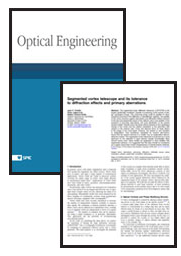
A Parallel Multiplication-Free Algorithm and Architecture for Affine-based Motion Compensation
Affine transformation is widely used in image processing. Recently, it has been recommended by MPEG-4 for video motion compensation. We present a novel low-power parallel architecture for texture warping using affine transformation (AT). The architecture uses a novel multiplication-free algorithm that employs the algebraic properties of the affine transformation. Low power has been achieved at different levels of the design. At the algorithmic level, replacing multiplication operations with bit shifting saves the power and delay of using a multiplier. At the architecture level, low power is achieved by using parallel computational units. At the circuit level, using low-power cells contributes to the power savings. The proposed architecture is used as a computational kernel in video object coders. It is compatible with MPEG-4 and virtual reality modeling language (VRML) standards. The architecture has been prototyped in 0.6-µm CMOS technology with three layers of metal. The performance of the proposed architecture shows that it can be used in mobile and handheld applications.
Wael Badawy and Magdy Bayoumi, “A Parallel Multiplication-Free Algorithm and Architecture for Affine-based Motion Compensation,” The SPIE Journal on Optical Engineering, Vol. 42 No. 1, January 2003 pp. 255 – 264

HOW IT CAME TO BE
“A Trip Around the World with DWIGHT L. ELMENDORF, Lecturer and Traveler.”
Venice is built on a group of little islands. At a depth of from ten to fifteen feet there is a firm bed of clay; below that a bed of sand or gravel, and then a layer of peat. Artesian wells dug to the depth of sixteen hundred feet have shown a regular succession of these beds. On this base, piles, where they have been used for the foundation, have become petrified. So the city may be described actually as having been built up from the bed of the sea. In its physical aspect it may be summed up by saying that Venice stands on 117 small islands formed by something like 150 canals and joined together by 378 bridges.
There is but little in the way of sidewalks. Occasional narrow paths of stone skirt the canals; but in many places the water laps the very walls of the buildings, and transportation is to be had only by boat. Of course there are many lanes and passages among the houses; but the general effect is such as would make an impression on the traveler of a city set in the sea, and the people live, move, and have their being on either stone or water. They are strangers to groves, shady lanes, and country places. Some of the inhabitants of Venice have never seen a horse or a cow.
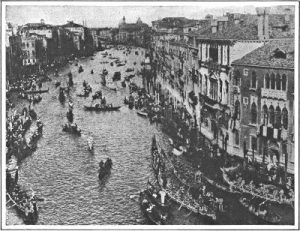 A GONDOLA
A GONDOLA
These black-painted craft take the place of cabs in Venice. They are propelled by a gondolier, who stands at the rear.
The city is divided into two parts by the Grand Canal, which is nearly two miles in length and varies from 100 to 200 feet in width. It makes a fine curve like the letter S, and by this it displays to advantage the magnificent residences that line it. There on its gleaming surface are to be seen the brilliant pageants of the city,—gondolas and autoboats in great number, gay parties, chatting and laughing and tossing flowers, and the whole stretch a blaze of intoxicating color. Some of the most attractive views of Venice are to be had not from within the canal, but from some point out in the lagoon. Your map of Venice will show you the city not literally situated in the Adriatic Sea, but located within the lagoon and protected from the outer sea by long sand hills strengthened by bulwarks of masonry. From the strip to the mainland, across the lagoon, where Venice is situated, the distance is about five miles, and in this stretch of water you will see many striped posts called “pali.” These mark the navigable channels about the city.
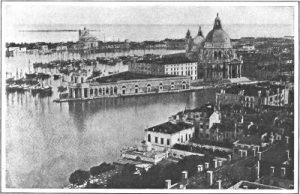 VENICE AND THE ADRIATIC SEA
VENICE AND THE ADRIATIC SEA
A panorama of the beautiful “Island City.”

